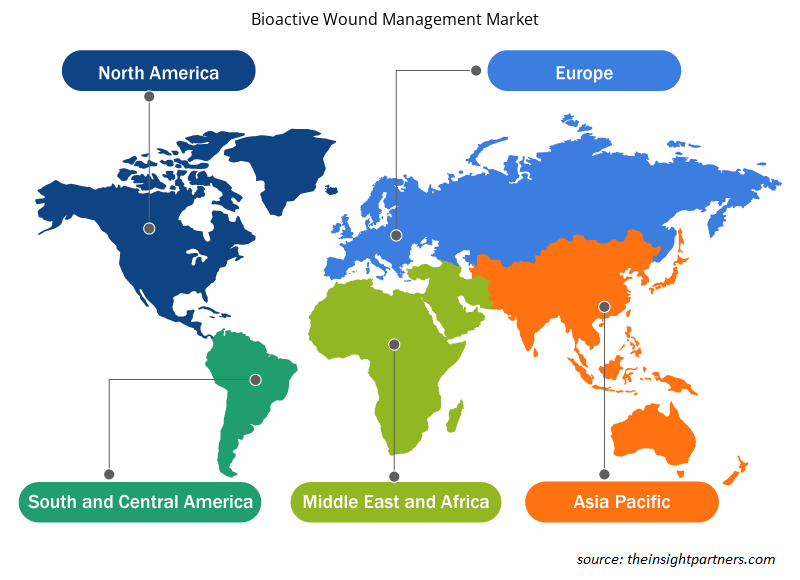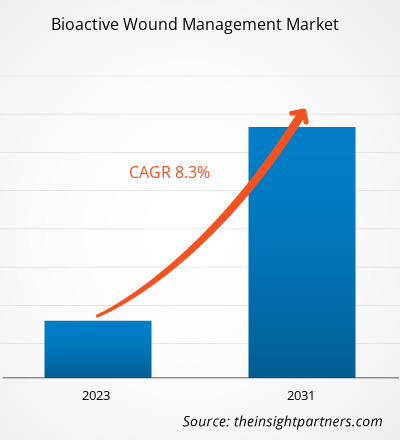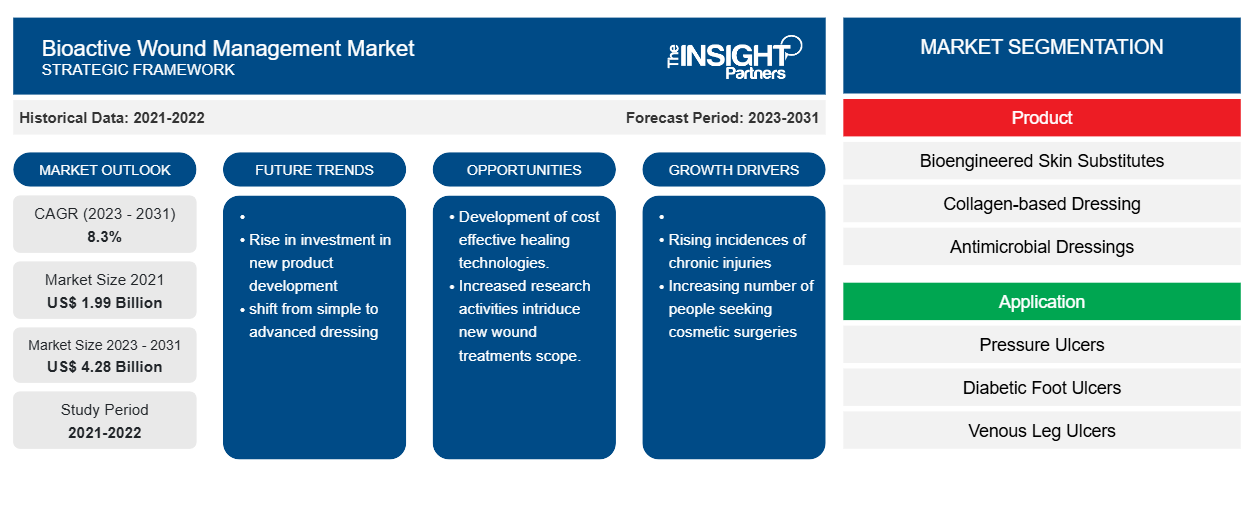Die Größe des Marktes für bioaktive Wundbehandlung wurde im Jahr 2021 auf 1,99 Milliarden US-Dollar und im Jahr 2023 auf XX Milliarden US-Dollar geschätzt und soll bis 2031 4,28 Milliarden US-Dollar erreichen; es wird geschätzt, dass er bis 2031 eine durchschnittliche jährliche Wachstumsrate von 8,3 % verzeichnen wird. Der 3D-Druck in der Wundversorgung wird voraussichtlich ein wichtiger Trend auf dem Markt für bioaktive Wundbehandlung bleiben.
Marktanalyse für bioaktive Wundbehandlung
Der Anstieg chronischer Verletzungen und die zunehmende Anzahl chirurgischer Eingriffe tragen zum Wachstum des Marktes für bioaktive Wundbehandlungen bei. Weltweit wird erwartet, dass die Prävalenz von Wundinfektionen aufgrund der steigenden Anzahl von Operationen steigt. Ein Anstieg der Anzahl chirurgischer Eingriffe weltweit ist auf die steigende Prävalenz verschiedener chronischer Krankheiten zurückzuführen. Laut Angaben der National Institutes of Health (NIH) werden in Europa jedes Jahr etwa 20 Millionen größere Operationen durchgeführt. Laut der Dubai Health Authority (DHA) wurden im Jahr 2021 in Dubai etwa 159.000 Operationen durchgeführt. Der gleichen Quelle zufolge hat sich die Zahl der Menschen, die in Dubai kosmetische Operationen wünschen, von 223.507 im Jahr 2020 auf 583.909 im Jahr 2022 verdoppelt. Bioaktive Wundbehandlungsprodukte ermöglichen eine schnelle Heilung von Wundinfektionen; die steigende Anzahl chirurgischer Eingriffe wird voraussichtlich die Nachfrage nach diesen Produkten in naher Zukunft ansteigen lassen.
Marktübersicht zur bioaktiven Wundbehandlung
Die Region Nordamerika hielt den größten Anteil am Markt für bioaktive Wundbehandlung. Der deutliche Anstieg der Investitionen für die Entwicklung neuer Produkte sowie die Präsenz führender Pharmagiganten in der Region dürften für die Dominanz des Marktes verantwortlich sein. Die nordamerikanischen Akteure verfügen über ein globales Netzwerk von Vertriebszentren, mit denen die Unternehmen mehrere Standorte auf der ganzen Welt erreichen können. Der asiatisch-pazifische Raum wird voraussichtlich die am schnellsten wachsende Region unter allen anderen Regionen sein. Das Wachstum des Marktes für bioaktive Wundbehandlung wird voraussichtlich in Ländern wie Indien, China und Australien am schnellsten sein. Das Marktwachstum in diesen Ländern wird voraussichtlich aufgrund der zunehmenden Verbreitung chronischer Wunden , der zunehmenden Zahl von Diabetikern und einer alternden Bevölkerung sowie der Verbesserung der Gesundheitseinrichtungen am schnellsten sein. Darüber hinaus bietet die Präsenz aktiver Wundbehandlungsorganisationen in der Region lukrative Möglichkeiten für das Wachstum des Marktes.
Passen Sie diesen Bericht Ihren Anforderungen an
Sie erhalten kostenlos individuelle Anpassungen an jedem Bericht, einschließlich Teilen dieses Berichts oder einer Analyse auf Länderebene, eines Excel-Datenpakets sowie tolle Angebote und Rabatte für Start-ups und Universitäten.
-
Holen Sie sich die wichtigsten Markttrends aus diesem Bericht.Dieses KOSTENLOSE Beispiel umfasst eine Datenanalyse von Markttrends bis hin zu Schätzungen und Prognosen.
Markttreiber und Chancen für bioaktive Wundbehandlung Wound Management Market Drivers and Opportunities
Innovationen bei modernen Wundpflegeprodukten begünstigen den Markt
Um der steigenden Nachfrage gerecht zu werden, werden mehrere kostengünstige Wundheilungstechnologien entwickelt. Die Entwicklungen in der Wundbehandlung haben zu einem Wechsel von einfachen Wundverbänden hin zu modernen Wundpflegeprodukten geführt. Moderne Wundverbände wurden entwickelt, um eine feuchte Umgebung zu schaffen, die die Heilung fördert. In Verbindung mit diesen Verbänden werden häufig Wundpflegeprodukte auf Keratinbasis verwendet, um die Reepithelisierung der Wunde zu unterstützen. Diese Produkte fördern eine schnellere Heilung, da sie von der Wunde aufgenommen werden, wodurch ein häufiger Verbandswechsel überflüssig wird. Darüber hinaus bietet die Verwendung biologischer Gerüstmaterialien, einschließlich einer intakten extrazellulären Matrix (ECM) oder einzelner Komponenten der ECM, neue therapeutische Optionen, die sich auf die Wundmikroumgebung konzentrieren und eine schnelle Wiederherstellung der Haut ermöglichen. re-epithelialization. These products facilitate faster healing by being absorbed into the wounds, which eliminates the need to frequently change the dressing. Furthermore, the usage of biological scaffold materials including an intact extracellular matrix (ECM) or individual components of the ECM provides new therapeutic options that focus on the wound microenvironment and facilitate rapid restoration of skin.
Nachfolgend sind einige Fortschritte bei Wundpflegeprodukten aufgeführt:
•Integra Life Sciences bietet eine breite Palette von Wundpflegeprodukten wie Integra Bilayer Wound Matrix, Integra Meshed Bilayer Wound Matrix und Integra Flowable Wound Matrix. Diese bestehen aus vernetztem Rinderkollagen, Glykosaminoglykan und Silikonüberzug. Sie werden zur Behandlung von partiellen und vollschichtigen Wunden, Druckgeschwüren, venösen Geschwüren, diabetischen Geschwüren, chronischen Gefäßgeschwüren und chirurgischen Wunden eingesetzt.
•Matristem (ACell Inc.) ist ein natürliches ECM-Gerüst, das aus nicht vernetzter porciner UBM-ECM besteht. Der Hauptvorteil von UBM-ECM gegenüber anderen natürlichen ECM-Produkten besteht darin, dass es die Basalmembrankomponente der Harnblase auf einer Oberfläche des biologischen Gerüsts behält. Die Basalmembran dient dazu, Epithelgewebe in Organen wie der Haut und Blutgefäßen an der ECM zu verankern.
Verstärkte Forschungsaktivitäten zur Einführung neuartiger Wundbehandlungen – eine Chance
Chronische Wunden können Chirurgen bei der effektiven Behandlung solcher Wunden Schwierigkeiten bereiten, was zu weiteren Komplikationen führen kann. Angesichts der steigenden Zahl von Patienten mit chronischen Wunden besteht ein wachsender Bedarf an einem systematischen Behandlungsansatz, der zur Einführung einer evidenzbasierten Behandlung geführt hat. Forschung und klinische Studien haben gezeigt, dass die Verwendung bioaktiver Wundpflegeprodukte die Heilung feuchter Wunden verbessern kann. Regierungsstellen und Forschungsuniversitäten spielen eine aktive Rolle bei der Förderung von Fortschritten in der Wundpflege, und mehrere Forschungsorganisationen widmen sich der Entwicklung fortschrittlicher Wundpflegeprodukte. Dies dürfte im Prognosezeitraum Wachstumschancen schaffen.
Nachfolgend sind einige Beispiele hierzu aufgeführt:
- Im Juli 2023 entwickelten Forscher der Queen's University Belfast eine neue Behandlung für diabetische Fußgeschwüre (DFU) mit einem 3D-gedruckten Verband, einem sogenannten Scaffold. Diese innovative Technologie kombiniert Lipidnanopartikel und Hydrogele, um personalisierte, hautähnliche Gerüste zu schaffen, die sowohl eine große Menge als auch eine anhaltende Freisetzung antibiotikahaltiger Moleküle zur Behandlung von DFU freisetzen. Diese Entdeckung hat das Potenzial, die Behandlung diabetischer Geschwüre deutlich zu verbessern.
- Im Juni 2023 stellten Forscher der Universität Birmingham eine neue Technik vor, die zeigte, wie Silber seine antimikrobiellen Eigenschaften über längere Zeiträume behalten kann, wenn es in „bioaktives Glas“ imprägniert wird. Diese Kombination bot im Vergleich zu konventionelleren Alternativen einen wirksameren und länger anhaltenden antimikrobiellen Wundschutz. Bioaktive Gläser – eine einzigartige Klasse synthetischer Biomaterialien, die aus Silikon hergestellt werden und seit mehreren Jahren bei Knochentransplantationen eingesetzt werden.
Marktbericht zur bioaktiven Wundbehandlung – Segmentierungsanalyse
Wichtige Segmente, die zur Ableitung der Marktanalyse zur bioaktiven Wundbehandlung beigetragen haben, sind Produkt, Anwendung und Endbenutzer.
- Basierend auf dem Produkt ist der Markt für bioaktive Wundbehandlung in biotechnologisch hergestellte Hautersatzstoffe, kollagenbasierte Verbände, antimikrobielle Verbände, Alginate und Hydrokolloide unterteilt. Das Segment Alginate hatte im Jahr 2023 den größten Marktanteil.
- Nach Anwendung ist der Markt in Dekubitusgeschwüre, diabetische Fußgeschwüre, venöse Beingeschwüre, Brandwunden und Operationswunden unterteilt. Das Segment Brandwunden hatte im Jahr 2023 den größten Marktanteil.
- In Bezug auf die Endverbraucher ist der Markt in Krankenhäuser und Kliniken, ambulante chirurgische Zentren und andere unterteilt. Das Segment Krankenhäuser und Kliniken dominierte den Markt im Jahr 2023.
Bioaktive Wundbehandlung – Marktanteilsanalyse nach geografischer Lage
Der geografische Umfang des Marktberichts zur bioaktiven Wundbehandlung ist hauptsächlich in fünf Regionen unterteilt: Nordamerika, Asien-Pazifik, Europa, Naher Osten und Afrika sowie Südamerika/Süd- und Mittelamerika. Nordamerika hat den Markt für bioaktive Wundbehandlung dominiert. Der Markt für bioaktive Wundbehandlung in den USA wird aufgrund verschiedener Faktoren voraussichtlich der größte und am schnellsten wachsende sein. Einige der treibenden Faktoren sind die Präsenz verschiedener Hersteller medizinischer Geräte, die Geräte und Produkte zur bioaktiven Wundbehandlung herstellen, und die Unterstützung der Regierung durch die Bereitstellung fortschrittlicher Werkzeuge, Technologien und Erfahrung für eine optimale Wundversorgung. Die Unternehmen in den USA verstärken ihre Präsenz, indem sie organische und anorganische Strategien verfolgen. So kündigte Medline Industries im Oktober 2021 eine Investition von 77,5 Millionen US-Dollar in den Bau eines neuen Vertriebszentrums in Kansas an. Daher bietet der steigende Bedarf in den USA an Wundverbänden eine erhebliche Chance für die wichtigsten Akteure, die Wundversorgung mit innovativen Produkten zu entwickeln. Der asiatisch-pazifische Raum wird in den kommenden Jahren voraussichtlich mit der höchsten CAGR wachsen.
Regionale Einblicke in den Markt für bioaktive Wundbehandlung
Die regionalen Trends und Faktoren, die den Markt für bioaktive Wundbehandlung während des Prognosezeitraums beeinflussen, wurden von den Analysten von Insight Partners ausführlich erläutert. In diesem Abschnitt werden auch die Marktsegmente und die Geografie für bioaktive Wundbehandlung in Nordamerika, Europa, im asiatisch-pazifischen Raum, im Nahen Osten und Afrika sowie in Süd- und Mittelamerika erörtert.

- Erhalten Sie regionalspezifische Daten zum Markt für bioaktive Wundbehandlung
Umfang des Marktberichts zur bioaktiven Wundbehandlung
| Berichtsattribut | Details |
|---|---|
| Marktgröße im Jahr 2021 | 1,99 Milliarden US-Dollar |
| Marktgröße bis 2031 | 4,28 Milliarden US-Dollar |
| Globale CAGR (2023 - 2031) | 8,3 % |
| Historische Daten | 2021-2022 |
| Prognosezeitraum | 2023–2031 |
| Abgedeckte Segmente |
Nach Produkt
|
| Abgedeckte Regionen und Länder |
Nordamerika
|
| Marktführer und wichtige Unternehmensprofile |
|
Marktteilnehmerdichte: Der Einfluss auf die Geschäftsdynamik
Der Markt für bioaktive Wundbehandlung wächst rasant, angetrieben durch die steigende Nachfrage der Endnutzer aufgrund von Faktoren wie sich entwickelnden Verbraucherpräferenzen, technologischen Fortschritten und einem größeren Bewusstsein für die Vorteile des Produkts. Mit der steigenden Nachfrage erweitern Unternehmen ihr Angebot, entwickeln Innovationen, um die Bedürfnisse der Verbraucher zu erfüllen, und nutzen neue Trends, was das Marktwachstum weiter ankurbelt.
Die Marktteilnehmerdichte bezieht sich auf die Verteilung von Firmen oder Unternehmen, die in einem bestimmten Markt oder einer bestimmten Branche tätig sind. Sie gibt an, wie viele Wettbewerber (Marktteilnehmer) in einem bestimmten Marktraum im Verhältnis zu seiner Größe oder seinem gesamten Marktwert präsent sind.
Die wichtigsten Unternehmen auf dem Markt für bioaktive Wundbehandlung sind:
- MiMedx
- Integra LifeSciences
- Organogenese
- Tissue Regenix Group Plc
- Coloplast
- Hartmann plc
Haftungsausschluss : Die oben aufgeführten Unternehmen sind nicht in einer bestimmten Reihenfolge aufgeführt.

- Überblick über die wichtigsten Akteure auf dem Markt für bioaktive Wundbehandlung
Marktnachrichten und aktuelle Entwicklungen zur bioaktiven Wundbehandlung
Der Markt für bioaktive Wundbehandlungen wird durch die Erhebung qualitativer und quantitativer Daten nach Primär- und Sekundärforschung bewertet, die wichtige Unternehmensveröffentlichungen, Verbandsdaten und Datenbanken umfasst. Im Folgenden finden Sie eine Liste der Entwicklungen auf dem Markt für bioaktive Wundbehandlungen:
- Im Juli 2022 führte Smith+Nephew die WOUND COMPASS Clinical Support App ein. Diese App ist ein umfassendes digitales Tool für medizinisches Fachpersonal, das bei der Wundbeurteilung und Entscheidungsfindung helfen soll, mit dem Ziel, Praxisabweichungen zu reduzieren. (Quelle: Smith+Nephew, 2022)
- Im Juni 2022 brachte Medline seinen Optifoam Gentle EX Foam Dressing auf den Markt. Das Produkt wurde entwickelt, um Druck zu verlagern, wenn es in Übereinstimmung mit dem Protokoll zur Vorbeugung von Druckverletzungen verwendet wird. Das Produkt verfügt über fünf einzigartige Schichten, die dabei helfen, Scherkräfte und Reibung zu absorbieren und Feuchtigkeit zu regulieren. (Quelle: Medline, 2022)
- Im Januar 2022 übernahm Convatec Triad Life Sciences Inc. Die Übernahme stärkt Convatecs Position im Bereich der fortschrittlichen Wundversorgung in den USA (Focus) und sichert den Zugang zu einer ergänzenden und innovativen Technologieplattform (Innovation), die die fortschrittliche Wundversorgung und die Behandlungsergebnisse verbessert. (Quelle: Convatec, 2022)
- Im Februar 2021 erhielt AxioBiosolutions die CE-Zertifizierung aus Europa für seine MaxioCel-Produktlinie fortschrittlicher Wundpflegeprodukte der nächsten Generation. Diese behördliche Zulassung ermöglicht Axio den Eintritt in den schnell wachsenden, 14 Milliarden US-Dollar schweren globalen Markt für fortschrittliche Wundpflege. (Quelle: AxioBiosolutions, 2021)
Marktbericht zur bioaktiven Wundbehandlung – Umfang und Ergebnisse
Der Bericht „Marktgröße und Prognose für bioaktive Wundbehandlung (2021–2031)“ bietet eine detaillierte Analyse des Marktes, die die folgenden Bereiche abdeckt:
- Marktgröße und Prognose auf globaler, regionaler und Länderebene für alle wichtigen Marktsegmente, die im Rahmen des Projekts abgedeckt sind
- Marktdynamik wie Treiber, Beschränkungen und wichtige Chancen
- Wichtige Zukunftstrends
- Detaillierte PEST/Porters Five Forces- und SWOT-Analyse
- Globale und regionale Marktanalyse mit wichtigen Markttrends, wichtigen Akteuren, Vorschriften und aktuellen Marktentwicklungen
- Branchenlandschaft und Wettbewerbsanalyse, einschließlich Marktkonzentration, Heatmap-Analyse, prominenten Akteuren und aktuellen Entwicklungen
- Detaillierte Firmenprofile
- Smith+Neffe
- Historische Analyse (2 Jahre), Basisjahr, Prognose (7 Jahre) mit CAGR
- PEST- und SWOT-Analyse
- Marktgröße Wert/Volumen – Global, Regional, Land
- Branchen- und Wettbewerbslandschaft
- Excel-Datensatz
Aktuelle Berichte
Verwandte Berichte
Erfahrungsberichte
Grund zum Kauf
- Fundierte Entscheidungsfindung
- Marktdynamik verstehen
- Wettbewerbsanalyse
- Kundeneinblicke
- Marktprognosen
- Risikominimierung
- Strategische Planung
- Investitionsbegründung
- Identifizierung neuer Märkte
- Verbesserung von Marketingstrategien
- Steigerung der Betriebseffizienz
- Anpassung an regulatorische Trends























 Kostenlose Probe anfordern für - Markt für bioaktive Wundbehandlung
Kostenlose Probe anfordern für - Markt für bioaktive Wundbehandlung